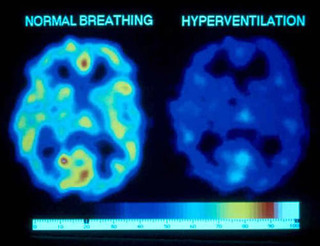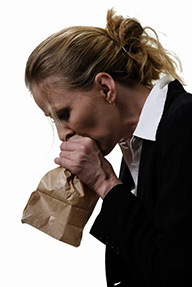A new treatment for panic attack focuses on getting patients to breathe less and lends further validation to the role that over-breathing plays in panic attacks and stress disorders.
Research published in the October issue of the Journal of Consulting and Clinical Psychology uses capno trainers to teach patients to take shallow breaths to ease panic symptoms.
At the Buteyko Breathing Clinic we have been teaching a simple, slow rhythmic breathing exercise that achieves exactly the same effect without the need for an expensive bio-feedback device like a capnotrainer. The exercise can be performed anywhere and at any time to help overcome a panic attack.
Panicking people are often told to calm down and "take a deep breath." However any advice to ‘breathe more’ may worsen the panic attack. The key to overcoming a panic attack is to breathe less (reduce hyperventilation).
Many breathing therapies focus on getting patients to breathe slower but slow breathing alone may not help alleviate a panic attack if patients are still hyperventilating.
If you experience a panic attack it is important to realise that you are not ‘losing your mind’. Most panic attacks are the result of a chemical imbalance in your blood. When we get stressed we tend to breathe more. This can cause a sudden drop in carbon dioxide levels in the blood. Paradoxically, a drop in carbon dioxide in the blood can reduce oxygen to the brain, bringing on a panic attack.
Effect of over-breathing on oxygen levels in the human brain
|

|
The MRI scan on the left shows normal levels of oxygen saturation of haemoglobin in the human brain. Red and yellow areas correspond to highest oxygen saturation.
The scan on the right is an image showing oxygen desaturation after one minute of voluntary over-breathing (hyperventilation).
|
Oxygen availability in the brain is reduced by 40% as a result of about a minute of over-breathing. Not only is oxygen availability reduced, but glucose critical to brain functioning is also markedly reduced as a result of cerebral vasoconstriction. (From Litchfield 2003)
|
Here are some simple tips to help if you think you are experiencing a panic attack:
- If possible, sit down and adopt a relaxed upright posture.
- Close your mouth and try to breathe in and out through your nose.
- Place the palm of your hand on your belly and imagine you are breathing into the palm of your hand.
- Slow your breathing and try to breathe rhythmically.
- Now the hardest part: try breathing less. This feels counter intuitive when the feeling accompanying a panic attack is usually one of suffocation. However, this is the key to restoring brain oxygen and switching off the ‘fight or flight’ response.
|
The science behind restoring oxygen levels in the brain is normalising carbon dioxide levels in the blood. An old remedy for a panic attack was to breathe into a paper bag (re-breathing your own carbon dioxide) helping to raise arterial CO2. While this can be effective it is no longer recommended as it can result in suffocation.
The Buteyko programme shows you how to control panic attacks and by helping retrain your breathing pattern, symptoms no longer return.
Click here to read the original article.




